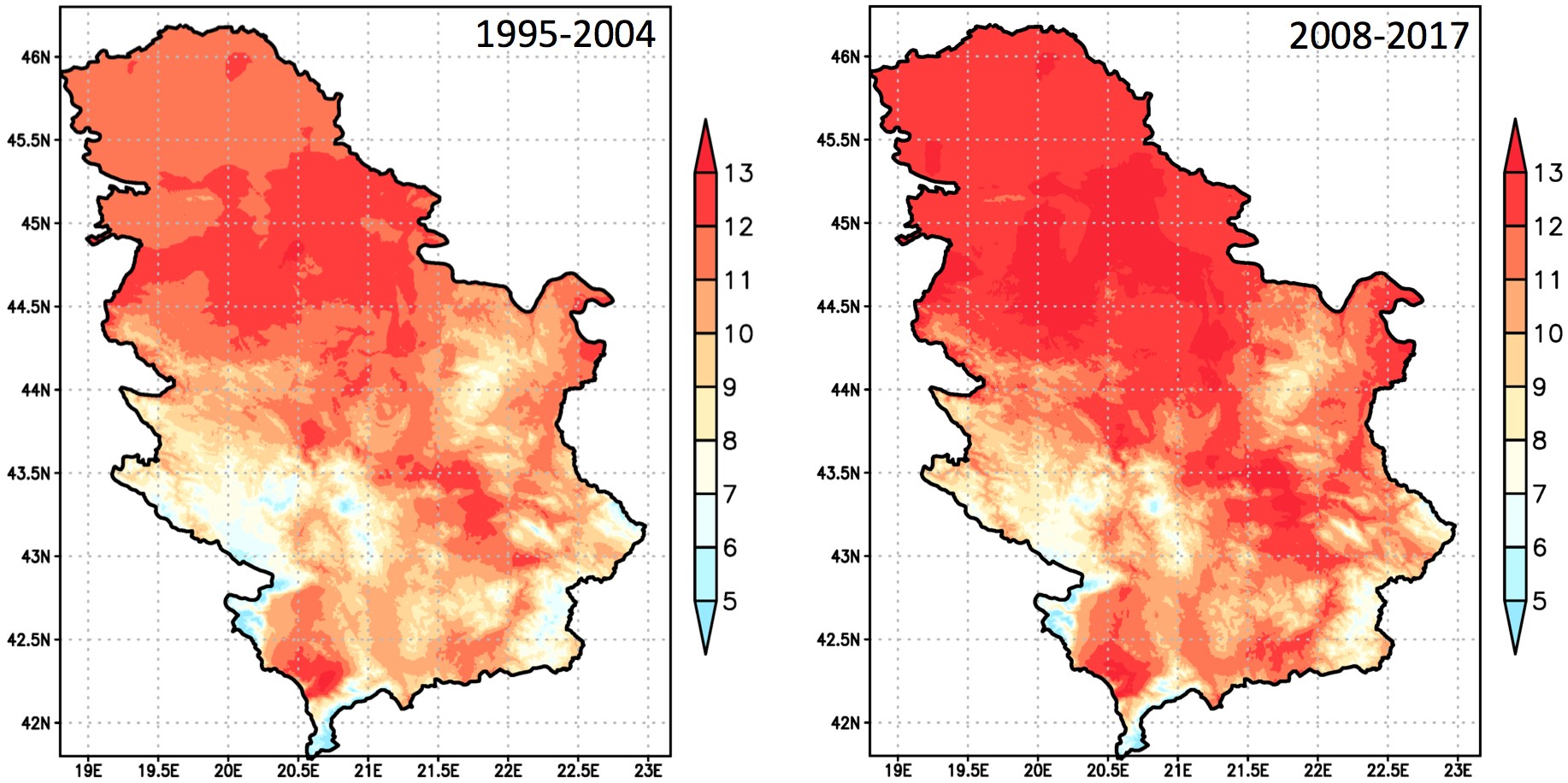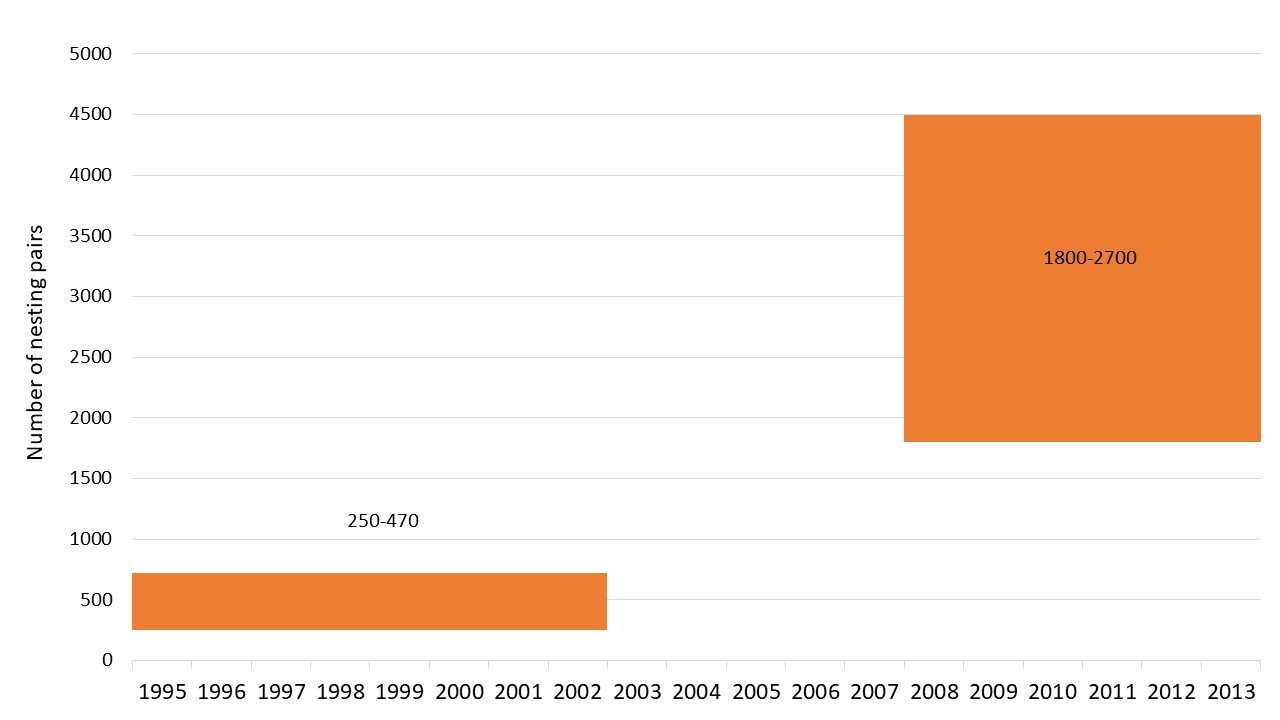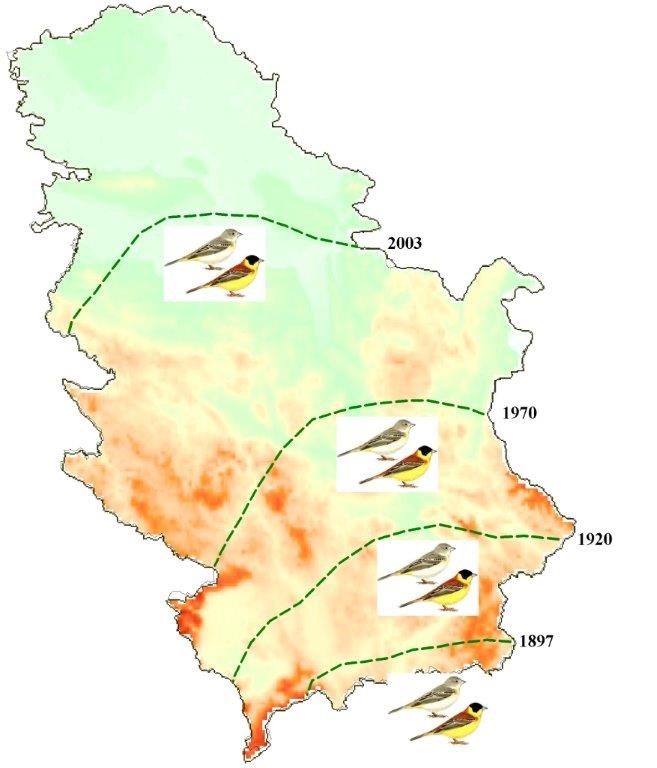Key message: Areal and population size of Black-Headed Bunting increase within the Climate Change
Assessment: The growth in number of Black-headed Bunting (Emberiza melanocephala) is оbserved on the territory of Serbia, as well as increasing the areal distribution from south to north of Serbia. The first observed habitats in Serbia until the mid-20th century were in the area of southern Serbia (Vranje, Niš, Pirot, etc.), and it is also known that at the end of the 19th century it certainly did not nest northern of Vranje. It began to appear occasionally in northern areas as well since the mid-20th century in drought and warmer years. Mostly areas of lower altitudes (up to about 400 m) are inhabited, but their occurrences are more rarely found at higher altitudes. During 2003, which was warm and dry during the period of settlement of this species, the Black-headed Buntings were also seen on the slopes of Fruška Gora at altitudes of up to 200 m. In addition to 2003, an important year for the settlement of this species on its way to warmer regions was 2000, which was also characterised by exceptionally warm and dry weather. Observed number of breeding pairs in two periods estimated for the territory of Serbia is: 250-470 for the period 1995-2002 and 1800-2700 for the period 2008-2013.
Parameters that are being tested for the analysis of favourable climatic conditions of the habitat of the Black-headed Bunting are:
- mean annual temperature;
- medium temperature for the period April-September.
Observed Black-headed Bunting habitats show that this type corresponds to warmer and drier weather in the period of their stay. Due to the impact of climate change, it has become convenient for this species to stay in thermal conditions in Serbia. The climate becomes similar to those in which their habitats are considered, south of Serbia – the area of south-eastern Europe, Italy, the Adriatic coast. This confirms that the movement of subtropical characteristics into the southern parts of Serbia and in the future, further to the north, also affects migration of species. Due to the occasional reporting of extremely moist episodes in some years in Serbia in May and June, there may still be variations in their number, but the trend of change shows that favourable conditions are created in the territory of Serbia in the areas of southern, central and northern Serbia, such as predicted by Huntley et al. 2004, but very likely faster than predicted, because temperature changes show faster warming than predicted.



Indicator Name: Climate Changes and Black-Headed Bunting areal and population size changes
Institution/Author: Faculty of agriculture, University of Belgrade/Dr Ana Vuković, Provincial Institute for Nature Conservation, Novi Sad/Nikola Stojnić, Environmental Protection Agency/Slaviša Popović
Use and interpretation:
Key question(s) which indicator helps to answer: Changes in population size of Black-Headed Bunting caused by climate changes
Use of indicator Investigation of Black-Headed Bunting areal
Scale of appropriate use On the territory of Serbia it was observed the growth in number of Black-headed Bunting and increasing the areal distribution from south to north of Serbia. The first observed habitats in Serbia until the mid-20th century are in the area of southern Serbia (Vranje, Niš, Pirot, etc.), and it is also known that at the end of the XIX century it certainly did not nest north of Vranje. Since the middle of the 20th century in drought and warmer years begins to appear from time to time and to the north. Mostly areas of lower altitudes (up to about 400m) are inhabited, but their occurrences are examined in more rare cases at higher altitudes.
Potential for aggregation:
Meaning of upward or downward trends: During the year 2003, which was warm and dry during the period of settlement of this species, the Black-headed Buntings were also seen on the slopes of Fruška Gora at an altitude of up to 200m. In addition to 2003, an important year after the settlement of this species on its way to warmer regions was 2000, which is also characterized by exceptionally warm and dry weather. Observed number of breeding pairs in two periods estimated for the territory of Serbia is: 250-470 for the period 1995-2002 and 1800-2700 for the period 2008-2013. Parameters that are being tested for the analysis of favourable climatic conditions of the habitat of the Black-headed Bunting are:
- mean annual temperature
- medium temperature for the period April-September
Possible reasons for upward or downward trends: significant increase in temperature in the period 1995-2004 and 2008-2017;
Implications for biodiversity management of change in the indicator:
Observed habitats in Europe, Black-headed Bunting show that this type corresponds to warmer and drier weather in the period of their stay. Due to the impact of climate change in the thermal conditions in Serbia have become convenient for a stay of this species. The climate becomes similar to those in which their habitats are considered, south of Serbia – the area of south-eastern Europe, Italy, the Adriatic coast. This confirms that the movement of subtropical characteristics into the southern parts of Serbia and in the future further to the north, also affects migration of species. Due to the occasional reporting of extremely moist episodes in some years in Serbia in May and June, there may still be variations in their number, but the trend of change shows that favourable conditions are created in the territory of Serbia in the areas of southern, central and northern Serbia, such as predicted by Huntley et al. 2004, but very likely faster than predicted, because temperature changes show faster warming than predicted.
Units in which it is expressed:
Number of nesting pairs
Description of source data: Faculty of Agriculture University of Belgrade, Provincial Institute for nature protection
Literature:
- Huntley, B. et. al., 2004: A Climatic Atlas of European Breeding Birds, Lynx Edicions;
- Puzović S. i Grubač B., 2003: Širenje areala rasprostranjenja crnoglave strnadice Emberiza melanocephala u Srbiji: prvo gnežđenje na Fruškoj gori i u Vojvodini, Glasnik društva za zaštitu i proučavanje ptica Vojvodine, vol. 12, Novi Sad, p. 180-183.
- Vuković, A. et al., 2018: global warming impact on climate change in Serbia for the period 1961-2100, Thermal Science, vol. 22, pp. 2267-2280;)
- Đurđević, V., Vukovic, A., Vujadinović, M., 2018: Osmotrene promene klime u Srbiji i projekcije buduće klime na osnovu različitih scenarija budućih emisija, Izveštaj, Program Ujedinjenih nacija za razvoj
Calculation procedure:
Particularly shown is the average temperature for the periods 1995-2004 and 2008-2017 for the months of April to September, as a period when the Black-Headed Bunting are in Serbia. The increase in temperature for this period of the year between the two observed 10-year periods in some areas is significantly more pronounced than the change in the average annual temperature, as the observed heating, as already mentioned, is the highest during the summer season and is visible in this six-month period. Thus, the warming up of the period of the year when this species is retained in Serbia is more pronounced than the increase in the mean annual temperature, which indicates the likely spread of a favourable area for the settlement of this species.
Most effective forms of presentation:
Map, graph
Limits to usefulness and accuracy:
Comparison with other climate factors has not been done
Updating the indicator:
For 10 year period
Closely related indicators
Climate Changes and flowering phenology of winter aconite
Additional information and comments
Table: Population size change of Black-Headed Bunting
| year | Number of nesting pairs | Number of nesting pairs |
| 1995 | 250 | 470 |
| 1996 | 250 | 470 |
| 1997 | 250 | 470 |
| 1998 | 250 | 470 |
| 1999 | 250 | 470 |
| 2000 | 250 | 470 |
| 2001 | 250 | 470 |
| 2002 | 250 | 470 |
| 2003 | ||
| 2004 | ||
| 2005 | ||
| 2006 | ||
| 2007 | ||
| 2008 | 1800 | 2700 |
| 2009 | 1800 | 2700 |
| 2010 | 1800 | 2700 |
| 2011 | 1800 | 2700 |
| 2012 | 1800 | 2700 |
| 2013 | 1800 | 2700 |
Areal and population size change of Black-Headed Bunting